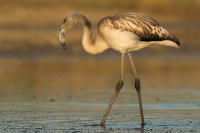Endangered speciesMore than one-third of the United States' threatened, and endangered species, live only in wetlands. Nearly half of them, are using wetlands at some point in their lives. Many other animals and plants, are depending on wetlands for survival. Estuarine and marine fish and shellfish, various birds, and certain mammals must have coastal wetlands to survive. Most commercial and game fish breed and raise their young in coastal marshes and estuaries. |
More about:
Wetlands are some of the most biologically productive natural ecosystems in the world.
Wetlands have important filtering capabilities.
Water storage is one of the important abilities of wetlands.
Wetlands function as natural sponges that trap and slowly release water.
The ability of wetlands to control erosion is very valuable.
We use a wealth of natural products from wetlands and use them for recreation.
Global warming and lack of knowledge are reasons why wetlands are threatened ecosystems.
|

 Menhaden, flounder, sea trout, spot, croaker, and striped bass are among the more familiar fish that depend on coastal wetlands. Shrimp, oysters, clams, and blue and Dungeness crabs, likewise need these wetlands for food, shelter, and breeding grounds. For many animals and plants, like wood ducks, muskrat, cattails, and swamp rose, the inland wetlands are the only places they can live. The beaver may actually create their own wetlands. For others, such as striped bass, peregrine falcon, otter,
Menhaden, flounder, sea trout, spot, croaker, and striped bass are among the more familiar fish that depend on coastal wetlands. Shrimp, oysters, clams, and blue and Dungeness crabs, likewise need these wetlands for food, shelter, and breeding grounds. For many animals and plants, like wood ducks, muskrat, cattails, and swamp rose, the inland wetlands are the only places they can live. The beaver may actually create their own wetlands. For others, such as striped bass, peregrine falcon, otter,